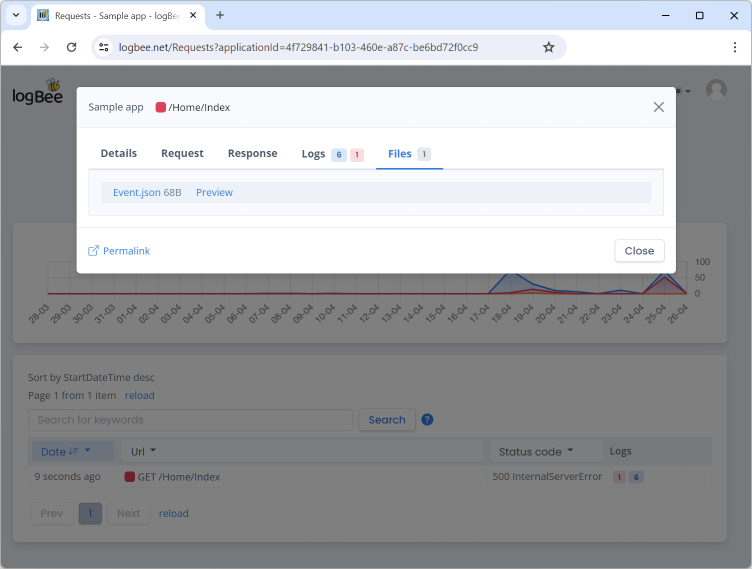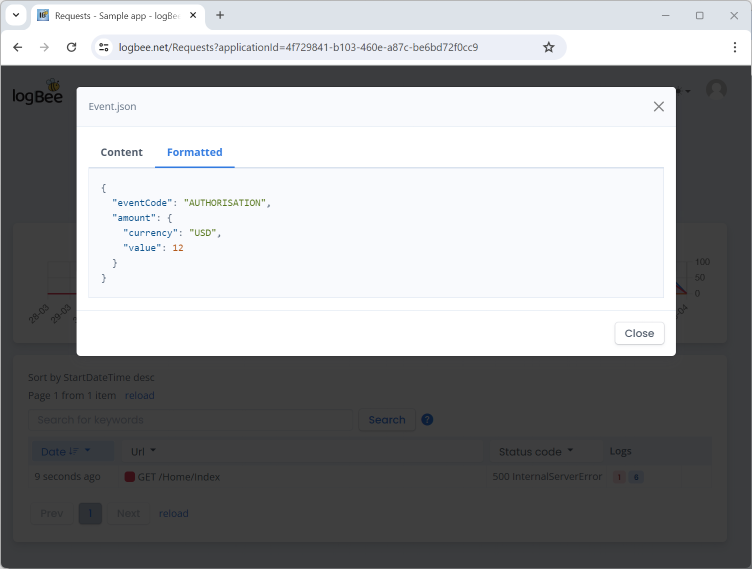Web applications¶
Web applications using Serilog can integrate the Serilog.Sinks.LogBee.AspNetCore Sink to write events to logBee.net.
var builder = WebApplication.CreateBuilder(args);
builder.Services.AddSerilog((services, lc) => lc
.WriteTo.LogBee(
new LogBeeApiKey("_OrganizationId_", "_ApplicationId_", "https://api.logbee.net"),
services
));
// make sure you register the LogBeeMiddleware just before the app.Run()
app.UseLogBeeMiddleware();
app.Run();
Saving the logs¶
The Serilog.Sinks.LogBee.AspNetCore Sink stores all the events in the current http request (connection).
At the end of the request, the stored events are sent automatically to the logBee endpoint specified in the Sink configuration.
In addition to the log events, the LogBee Serilog Sink also collects all the HTTP properties of the current execution request.
Note
Make sure you register the LogBee middleware by calling app.UseLogBeeMiddleware() before the app.Run()
Configuration¶
Additional LogBee Serilog Sink configuration can be provided using the config parameter.
var builder = WebApplication.CreateBuilder(args);
builder.Services.AddSerilog((services, lc) => lc
.Enrich.WithCorrelationId()
.WriteTo.LogBee(
new LogBeeApiKey("_OrganizationId_", "_ApplicationId_", "https://api.logbee.net"),
services,
config =>
{
config.ShouldReadRequestHeader = (request, header) =>
{
// we don't want to log sensitive Header value
if (string.Equals(header.Key, "X-Api-Key", StringComparison.OrdinalIgnoreCase))
return false;
return true;
};
// handler used to determine if a Request should be saved to logBee endpoint or not
config.ShouldLogRequest = (context) =>
{
if (string.Equals(context.Request.Path, "/status/healthcheck", StringComparison.OrdinalIgnoreCase)
&& context.Response.StatusCode < 400)
{
return false;
}
return true;
};
config.AppendExceptionDetails = (ex) =>
{
if (ex is NullReferenceException nullRefEx)
return "Don't forget to check for null references";
return null;
};
config.RequestKeywords = (context) =>
{
var keywords = new List<string>();
if (context.Items.TryGetValue("CorrelationIdEnricher+CorrelationId", out var value)
&& value is string correlationId)
{
// add the Serilog CorrelationId as a search keyword
keywords.Add(correlationId);
}
return keywords;
};
}
));
Logging files¶
With Serilog.Sinks.LogBee.AspNetCore you can log string content as files.
In order to do so, you need to access the LoggerContext by using the HttpContext.GetLogBeeLoggerContext() extension method.
public class HomeController : Controller
{
public IActionResult Index()
{
var loggerContext = HttpContext.GetLogBeeLoggerContext();
loggerContext?.LogAsFile(JsonSerializer.Serialize(new
{
eventCode = "AUTHORISATION",
amount = new
{
currency = "USD",
value = 12
}
}), "Event.json");
return View();
}
}


For technical support, questions or any feedback, please feel free to send us a message and we will get back to you.